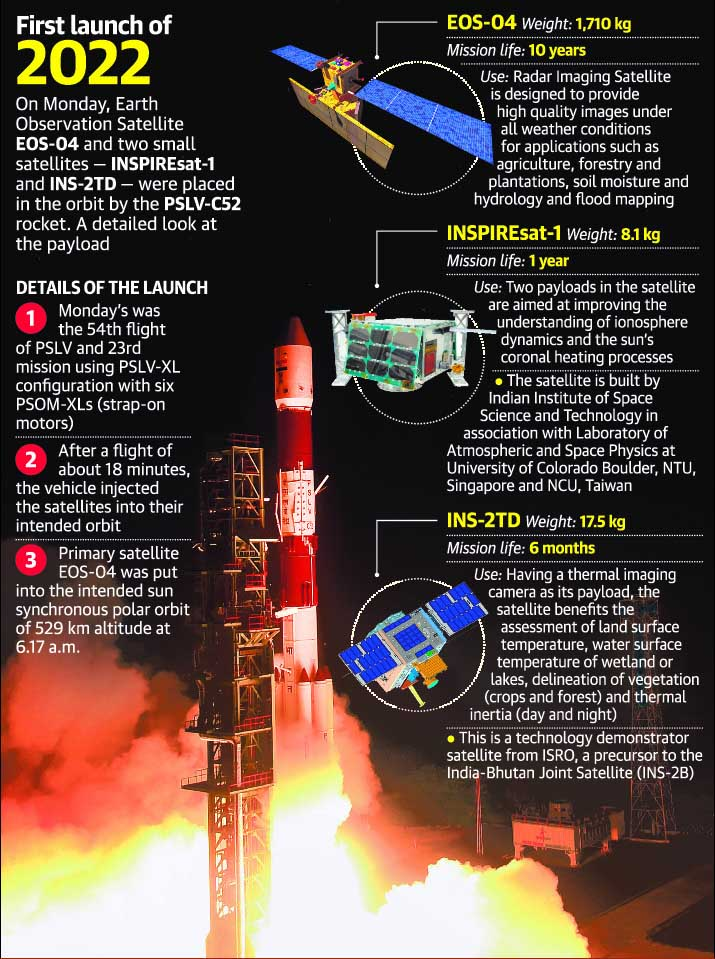Important Facts For Prelims
Earth Observation Satellite: EOS-02
- 08 Apr 2022
- 4 min read
Why in News?
The Union Minister of Science & Technology said that EOS (Earth Observation Satellite)-02 satellite will be launched in the second quarter of 2022.
- The launch was delayed due to pandemic and consequent lockdown.
- Earlier, the Indian Space Research Organisation's earth observation satellite EOS-04 and two small satellites (INSPIREsat-1 and INS-2TD) were successfully placed into the intended orbit by the PSLV (Polar Satellite Launch Vehicle)-C52 rocket.
What is the EOS-02 Satellite?
- EOS-02 is Technology demonstration satellite for various new technologies with applications that include agriculture, forestry, geology, hydrology, miniaturised power electronics, reaction wheels etc. and forming the payload for SSLV (Small Satellite Launch Vehicle)-1.
- SSLV is the smallest vehicle weighing only 110-tonne. It will take only 72 hours to integrate, unlike the 70 days taken now for a launch vehicle.
- It aims to cater to the market for the launch of small satellites into Earth’s low orbits that has emerged in recent years to cater to the needs of developing countries, universities for small satellites, and private corporations.
What are the Other Satellites in the EOS Series?
- EOS-01:
- Earth Observation satellite meant for Agriculture, Forestry & disaster management support
- EOS-03:
- First Agile Earth Observation satellite in Geostationary orbit and applications which include near real time imaging, quick monitoring of natural disasters, spectral signatures for agriculture, forestry etc.
- EOS-04:
- EOS-05:
- Earth Observation Satellite in the Geostationary Orbit.
- EOS-06:
- Earth Observation satellite meant for applications, which include ocean related services and advisories towards potential fishing zone forecast , ocean state forecast.
What are Earth Observation Satellites?
- Earth observation satellites are the satellites equipped with remote sensing technology. Earth observation is the gathering of information about Earth's physical, chemical and biological systems.
- Many earth observation satellites have been employed on sun-synchronous orbit.
- Other earth observation satellites launched by ISRO include RESOURCESAT- 2, 2A, CARTOSAT-1, 2, 2A, 2B, RISAT-1 and 2, OCEANSAT-2, Megha-Tropiques, SARAL and SCATSAT-1, INSAT-3DR, 3D, etc.
UPSC Civil Services Examination, Previous Year Questions (PYQs)
Q. With reference to the Indian Regional Navigation Satellite System (IRNSS), consider the following statements: (2018)
- IRNSS has three satellites in geostationary and four satellites in geosynchronous orbits.
- IRNSS covers entire India and about 5500 sq. km beyond its borders.
- India will have its own satellite navigation system with full global coverage by the middle of 2019.
Which of the statements given above is/are correct?
(a) 1 only
(b) 1 and 2 only
(c) 2 and 3 only
(d) None
Ans: (a)
- Indian Regional Navigation Spacecraft System (IRNSS) is an independent regional navigation satellite system being developed by India.







